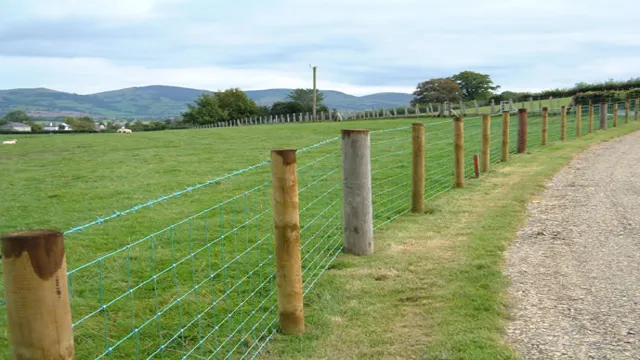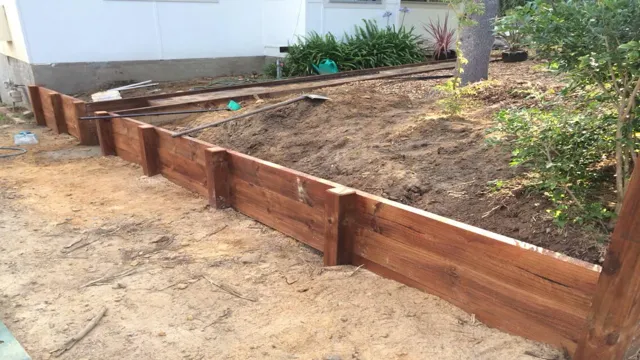Can You Use Landscaping Timbers for Fence Posts? Pros, Cons, and Solutions.

If you’re thinking of building a fence, you may have read about using landscaping timbers as fence posts. It’s not an uncommon choice among homeowners who want to save money on materials and labor costs. However, before you dive straight into using landscaping timbers as fence posts, it’s important to weigh the pros and cons.
On one hand, using landscaping timbers can be an affordable and durable option, but on the other hand, it may not last as long as other materials and may not be suitable for all types of soil. So, let’s dive into the pros and cons of using landscaping timbers as fence posts and see if it’s the right choice for your project.
Introduction: The Potential of Landscaping Timbers as Fence Posts
If you’re looking for an affordable and sturdy option for your fence posts, you might be wondering if landscaping timbers could be a viable solution. Fortunately, the answer is yes! Landscaping timbers are a fantastic choice for fence posts because they are durable, easy to work with, and cost-effective. Unlike traditional wooden fence posts, which can rot or warp over time, landscaping timbers are treated with preservatives that make them more resistant to moisture and pests.
This means that they can last for years without needing to be replaced. Additionally, landscaping timbers are easy to cut and shape, which means that you can customize them to fit your specific needs. Whether you’re building a privacy fence, a boundary fence, or an accent fence, landscaping timbers can be a great choice for your project.
So if you’re looking for a inexpensive and reliable way to get your fence up and running, landscaping timbers are definitely worth considering.
What are Landscaping Timbers?
Landscaping timbers are large wooden boards or beams typically used for building garden and landscape features such as fences, retaining walls, and garden beds. These timbers are made from various wood species such as cedar, redwood, and pine and come in different sizes and shapes. One potential use for landscaping timbers is as fence posts, which are essential for securing a fence and keeping it upright.
Using landscaping timbers as fence posts can provide a natural and rustic look to your garden or landscape while also providing versatile and sturdy support for your fence. The benefits of using landscaping timbers as fence posts include their affordability, easy installation, and durability. Additionally, they can be easily customized to fit specific size requirements by cutting them down to size.
Overall, landscaping timbers offer a great solution for anyone looking to build a durable and aesthetically pleasing fence for their garden or landscape.

The Benefits of Using Landscaping Timbers as Fence Posts
Landscaping Timbers as Fence Posts Have you ever considered using landscaping timbers as fence posts? They may not be the first material that comes to mind, but these sturdy and versatile pieces of wood can make for a great fencing solution. Landscaping timbers are not only affordable, but also environmentally friendly, making them a popular choice for homeowners who want to build fences without breaking the bank. Using them as fence posts can offer several benefits, including improved durability, a natural and rustic look, and easy installation.
With its robustness and practicality, landscaping timbers are an excellent choice for fence posts. By using landscaping timbers, you can build a fence that not only serves its purpose but also adds an attractive touch to your outdoor space.
Disadvantages of using landscaping timbers for fence posts
While landscaping timbers can be a great choice for fence posts due to their durability and affordability, there are some potential disadvantages to consider. One major issue is the risk of rot and decay over time, especially if the timbers are in contact with soil or water. This can weaken the posts and lead to instability or collapse, requiring costly repairs or replacement.
Additionally, landscaping timbers may not be as strong as other materials such as steel or concrete, meaning they may not be suitable for supporting heavy or high-pressure fencing. Finally, using timbers as fence posts may not always be aesthetically pleasing, as they can appear bulky or out of place in certain landscapes. Therefore, it’s important to weigh the pros and cons carefully before deciding whether landscaping timbers are the right choice for your fence posts.
Factors to Consider When Choosing the Right Fence Posts
When it comes to choosing the right fence posts for your property, it’s important to consider a variety of factors. One common question is whether landscaping timbers can be used as fence posts. While they may seem like a cost-effective option, there are some important things to consider before making a decision.
First and foremost, it’s important to choose a material that is strong enough to support the fence. Landscaping timbers may be strong enough for certain types of fences, but may not be suitable for larger or heavier structures. Additionally, they may not be treated for outdoor use, which can lead to rot or degradation over time.
Another factor to consider is the overall aesthetic of your property. Landscaping timbers may not match the look of your existing landscaping or the style of your home. In some cases, using a different material may be a better option to maintain a cohesive look.
Ultimately, the best choice for fence posts will depend on your specific needs and preferences. Working with a professional can help ensure that you choose the right material for your property and avoid any potential issues down the line.
Durability and Strength
When it comes to choosing the right fence posts for your property, durability and strength should be your top priority. Ensuring that your fence posts can withstand the weather conditions and some wear and tear is essential for maintaining the security and privacy of your property. It is important to consider the type of material used for the fence posts, such as wood, metal, or vinyl, as this will affect their strength and lifespan.
Additionally, the thickness and weight of the posts must be taken into account, especially if the fence is meant to enclose animals or provide additional security measures. By choosing fence posts that are resilient and robust, you can be assured that your fence will last for many years without requiring frequent repairs or replacements.
Costs
When it comes to choosing the right fence posts, one of the most important factors to consider is the cost. Your budget will help determine which type of fence post is best for you. Wooden fence posts are the most affordable option, but they require regular maintenance and may need to be replaced more often than other materials.
Steel fence posts are more expensive but are incredibly durable and low maintenance. If you’re looking for an eco-friendly option, consider using recycled plastic fence posts. Although they may cost more upfront, they can save you money in the long run by requiring no maintenance or replacements.
Overall, the cost of the fence posts should be carefully evaluated in relation to the durability, maintenance requirements, and expected lifespan of the posts before making a final decision.
Aesthetics
When it comes to choosing the right fence posts, there are a few key factors to keep in mind. One of the most important considerations is the type of material the posts are made from. Wooden posts are a popular option for their natural aesthetic, but may require more maintenance over time.
Metal posts, on the other hand, offer durability and require less upkeep. It’s also essential to think about the size and height of the posts, as this can impact the overall look and feel of your fence. Additionally, consider the spacing between posts and any decorative elements or finials that may enhance the appearance of your fence.
By taking these factors into account, you can select the perfect fence posts to complement your property and achieve the desired aesthetic.
Availability and Accessibility
When it comes to choosing the right fence posts, there are two important factors to consider: availability and accessibility. First and foremost, it’s important to choose fence posts that are readily available in your area. This will make it easier to purchase and install your fence without any unexpected delays.
You should also consider the accessibility of your fence posts, especially if you plan on installing the fence yourself. Make sure the posts are easy to handle and work with, as well as durable enough to withstand the elements. Overall, choosing the right fence posts is crucial for ensuring the long-term stability and security of your fence.
So take your time, do your research, and choose a post that meets your needs and budget.
FAQs on the Use of Landscaping Timbers for Fence Posts
Yes, it is possible to use landscaping timbers for fence posts. However, it is important to note that there are some factors to consider when doing so. Landscaping timbers are typically made of treated wood, which means that they have been chemically treated to prevent rotting and insect damage.
While this can be beneficial for fence posts, it is also important to make sure that the wood is properly dried before using it. Wet wood can warp and crack over time, which can compromise the structural integrity of the fence. Additionally, it is important to make sure that the timbers are properly anchored into the ground and that they are spaced appropriately for the type of fence being installed.
Overall, using landscaping timbers for fence posts can be a cost-effective and durable option, but it is important to take the necessary precautions to ensure that the fence will be sturdy and long-lasting.
Can Landscaping Timbers Replace Regular Fence Posts?
If you’re considering using landscaping timbers as fence posts, you probably have a lot of questions about whether or not they’ll work. One of the biggest concerns is whether or not the timbers are strong enough to support a fence. While landscaping timbers can be strong, they may not be as sturdy as traditional fence posts made of cedar, pine, or other durable materials.
This means they may not be suitable for every fence project, particularly those in areas with high winds or heavy soil conditions. Additionally, you’ll need to make sure the timbers are treated to resist decay and rot, as they can be susceptible to water damage if left untreated. Overall, while landscaping timbers can be a good option in some cases, it’s important to weigh the pros and cons before making a decision.
How Deep Should I Install Landscaping Timber Fence Posts?
Landscaping Timbers, Fence Posts, Install If you’re planning on using landscaping timbers for fence posts, then you’ll want to make sure that you install them deep enough to provide adequate stability and support for your fence. So how deep should you install your landscaping timber fence posts? Well, it ultimately depends on a few different factors. For instance, the type of soil you have, the height of your fence, and the climate in your area all play a role in determining the appropriate depth for your fence posts.
In general, you’ll want to dig a hole that is approximately 1/3 the length of your timber post and then fill the bottom of the hole with gravel or concrete to create a sturdy foundation. Then, you can insert your landscaping timber post into the hole and backfill the rest of the hole with soil, compacting it as you go. This will help to ensure that your fence stays securely in place, even during inclement weather or high winds.
Conclusion: Making the Right Choice for Your Fence Posts
In conclusion, using landscaping timbers for fence posts is a creative way to add a rustic and unique touch to your property. However, it’s important to keep in mind that these timbers may not be as durable or long-lasting as traditional fence posts. So while it may be tempting to use them for a quick and easy solution, investing in stronger materials for your fence may save you time and money in the long run.
As they say, “when it comes to fencing, it’s better to be safe than timber-sorry!”
FAQs
What are landscaping timbers?
Landscaping timbers are wooden planks used for creating landscape features such as garden edging, raised beds, retaining walls, and walkways.
Can landscaping timbers be used as fence posts?
Yes, landscaping timbers can be used as fence posts, but it is recommended to use treated timbers to protect against rot and decay.
What is the advantage of using landscaping timbers as fence posts?
Landscaping timbers are an affordable and readily available option for fence posts. They are also easy to work with and can be cut to size using basic tools.
How long do landscaping timbers last when used as fence posts?
The lifespan of landscaping timbers as fence posts depends on various factors such as the type of timber used, weather conditions, and maintenance. Treated timbers can last up to 20 years.
Can landscaping timbers be painted or stained?
Yes, landscaping timbers can be painted or stained to match your desired fence color or style. However, it is recommended to use a paint or stain that is suitable for outdoor use.
How deep should landscaping timbers be installed as fence posts?
It is recommended to bury the landscaping timbers at least 2 feet deep to ensure adequate stability and support for the fence.
Can landscaping timbers be used in areas with high moisture or humidity?
Landscaping timbers can be used in areas with high moisture or humidity, but it is important to use treated timbers and apply a sealant to protect against rot and decay.




